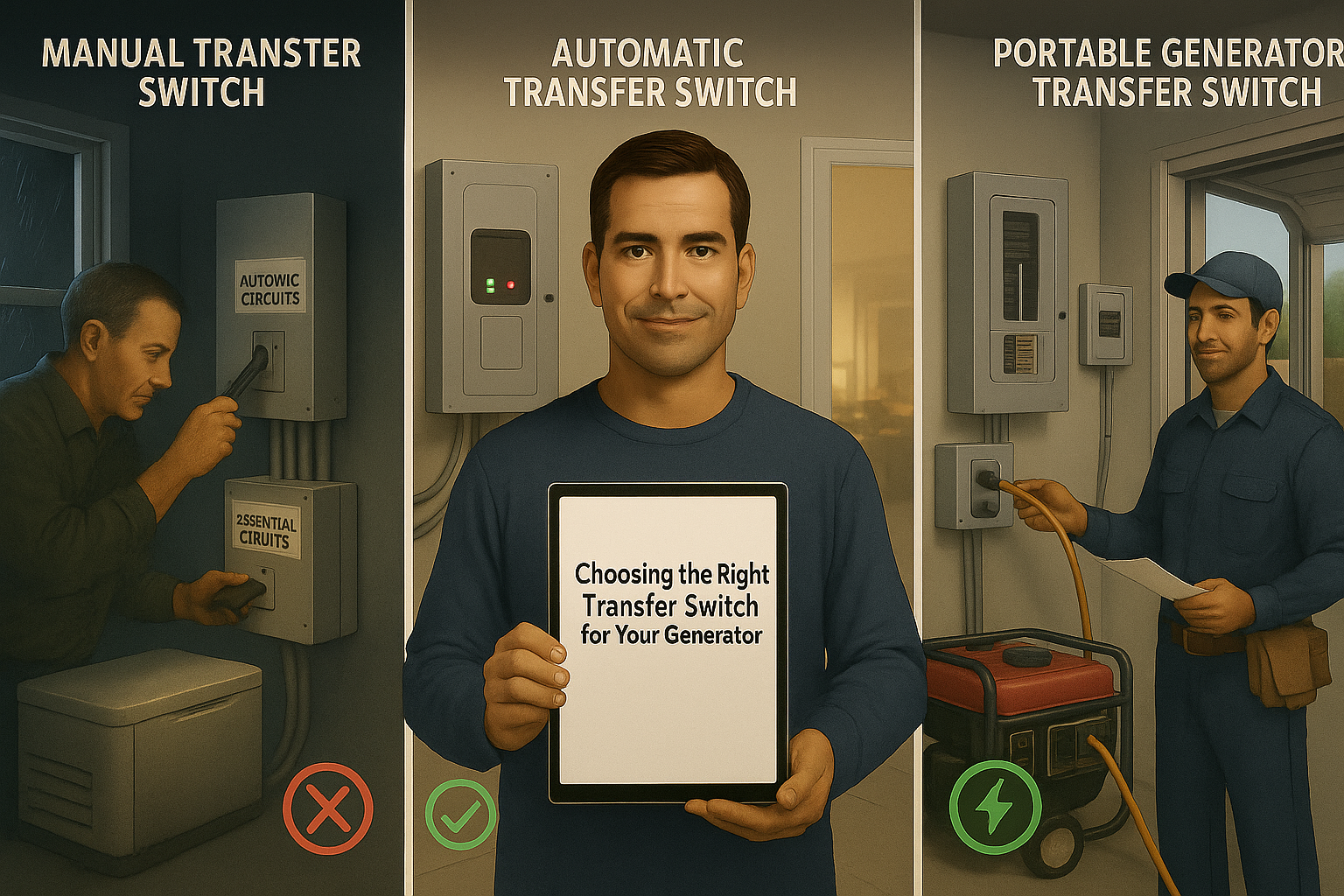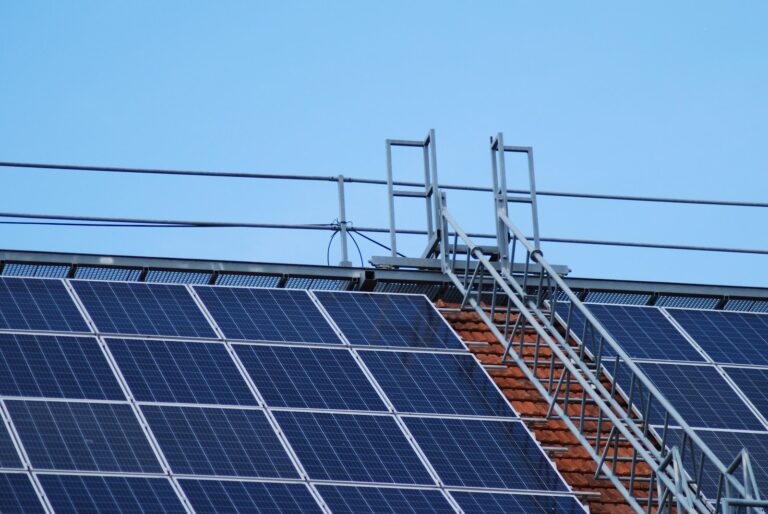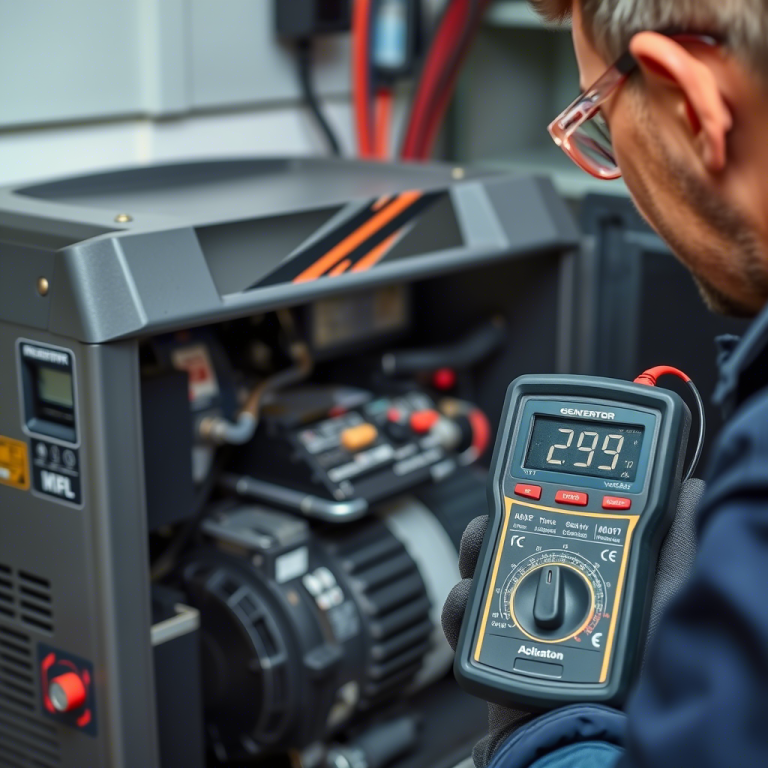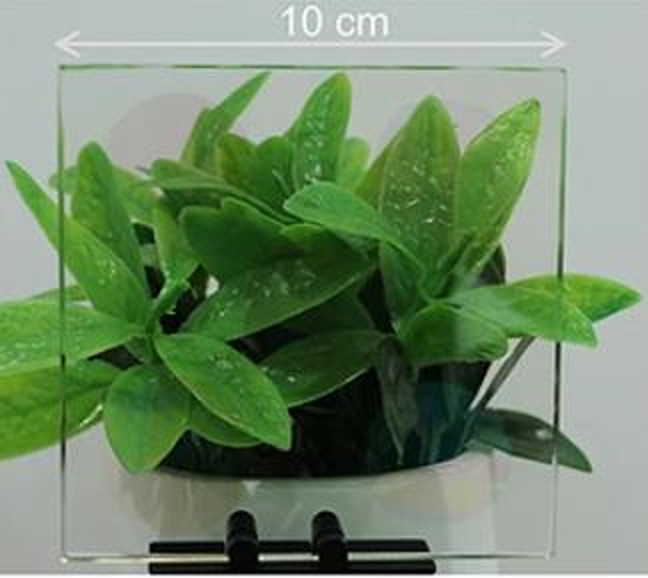Choosing the Right Transfer Switch for Your Generator: A Comprehensive Guide
We’ve all experienced it: the lights flicker, then go out. The hum of appliances stops. Suddenly, you’re reminded just how dependent modern life is on electricity. As someone who has dealt with the inconvenience of unexpected power outages, I know that owning a generator is only half the solution. The real key to seamless and safe backup power lies in choosing the right transfer switch — the critical bridge between your generator and your home’s electrical system.
Get this decision wrong, and your generator might not work when you need it most — or worse, it could pose serious safety risks.
This guide will walk you through everything you need to know about transfer switches:
- What they are
- The different types available
- Their pros and cons
- And how to choose one that fits your specific needs
While this information empowers you to make informed decisions, consulting with a licensed electrician is essential for a safe, code-compliant installation tailored to your home.
Let’s explore your options and find the ideal transfer switch for your peace of mind.
Understanding Your Transfer Switch Options: Manual, Automatic & Portable
Transfer switches are the gatekeepers of your backup power system. They safely isolate your home from the utility grid when your generator is running, preventing dangerous “backfeed” that could electrocute utility workers or damage equipment.
Here’s a breakdown of the three main types:
1. Manual Transfer Switches (MTS): The Hands-On Choice
How They Work:
A manual transfer switch requires you to physically flip a switch to connect your generator to your home’s circuits during an outage. You’ll also need to start the generator yourself and manually operate the switch to route power into your home.
Pros:
- Cost-Effective: Typically the most affordable type of transfer switch.
- Simple Installation: Easier and less expensive to install than automatic options.
- Straightforward Operation: No complex electronics involved — just basic mechanical switching.
Cons:
- Requires Manual Intervention: You must be present and able to operate the switch during an outage (not ideal if you’re away or unable to respond).
- Delayed Power Restoration: There’s a time gap between the outage and when you manually start the generator and flip the switch.
- Limited Circuit Selection: Usually powers only a pre-selected set of essential circuits (e.g., furnace, fridge, lights), not your entire panel.
Example:
Imagine a family living in a rural area prone to winter storms. They own a standby generator but prefer a manual transfer switch because they’re usually at home and want to save money. When the power goes out, they head outside to start the generator, then go back inside and flip the switch to restore power to the kitchen, heating system, and internet modem.
2. Automatic Transfer Switches (ATS): The “Set It and Forget It” Solution
How They Work:
An automatic transfer switch constantly monitors your utility power. The instant an outage is detected, it sends a signal to start your standby generator, waits for it to stabilize, and then automatically transfers your home’s electrical load to the generator — all within seconds, often without you even noticing. When utility power returns, it seamlessly switches back and shuts the generator down.
Pros:
- Seamless Power Transition: Eliminates delays and manual effort. Power is restored almost instantly.
- Convenience & Peace of Mind: Ideal for situations where you may not be home or able to respond immediately (e.g., elderly individuals, frequent travelers).
- Whole-House Power (Potentially): Can be sized to power your entire home electrical panel if paired with a sufficiently large standby generator.
Cons:
- Higher Cost: Significantly more expensive than manual switches, both for the unit and installation.
- Complex Installation: Requires sophisticated wiring and integration with your generator’s controller and main electrical panel; must be done by a qualified electrician.
- Regular Maintenance: Needs periodic testing and maintenance to ensure reliable automatic operation.
- Generator Requirement: Designed specifically for permanently installed standby generators with automatic start capabilities.
Example:
A small medical office uses an automatic transfer switch connected to a standby generator. During a summer blackout caused by a lightning strike, the ATS detects the loss of power, starts the generator, and restores electricity to the building in under 10 seconds. The staff never notices the outage, and life-support equipment continues to function without interruption.
3. Portable Generator Transfer Switches: For On-the-Go Power
How They Work:
Installed near your main panel, these switches provide a safe, dedicated connection point for your portable generator’s output cable. You manually plug the generator in and then switch circuits over during an outage. These switches often look like small subpanels with individual circuit breakers.
Pros:
- Affordable Safety: Provides a much safer alternative to dangerous “suicide cords” for connecting portable generators.
- Relatively Easy Installation: Simpler than an ATS, often installed as an interlock or subpanel.
- Portability Leveraged: Works with the generator type most people already own.
Cons:
- Less Protection: While safer than no switch, they generally offer fewer safety features than a full MTS or ATS integrated directly with the main panel.
- Manual Operation Required: Still need to start the generator, plug it in, and manually switch circuits.
- Limited Circuit Capacity: Powers a limited number of pre-selected essential circuits.
- Not for Permanent Generators: Not designed or suitable for use with permanently installed standby generators.
Example:
A homeowner owns a portable generator and wants to safely power their refrigerator, a few lights, and a sump pump during occasional outages. They install a portable generator transfer switch near their electrical panel. During a storm, they wheel the generator outside, plug it into the switch, and toggle the necessary circuits — restoring power safely and efficiently without risking backfeeding the grid.
Key Considerations: Choosing What’s Right for YOU
Selecting a transfer switch isn’t one-size-fits-all. The right choice depends heavily on your specific setup and needs.
1. Your Generator Type is Paramount
- Standby Generator (Permanently Installed): Best paired with either a Manual Transfer Switch (MTS) or, more commonly, an Automatic Transfer Switch (ATS). The ATS is the standard and expected pairing for seamless operation.
- Portable Generator: Requires a Portable Generator Transfer Switch or a Manual Transfer Switch designed for portable generator input. Never connect a portable generator directly to your panel without a proper transfer device!
2. Budget Realistically
Factor in not just the cost of the switch itself, but also professional installation (especially critical for ATS systems), potential electrical panel upgrades, and any necessary permits. Automatic transfer switches represent a significant investment, but they offer unmatched convenience and reliability.
3. Convenience vs. Control
How critical is instant, automatic power restoration?
- If you have medical equipment, travel frequently, or simply value maximum convenience, an ATS is worth the premium.
- If you’re comfortable with a manual process and are always home during potential outages, a manual switch or portable transfer switch might suffice.
4. Powering Needs
What circuits must run during an outage?
Examples include:
- Refrigerator
- Furnace or HVAC blower
- Well pump
- Sump pump
- Essential lighting
- Medical devices
Ensure the switch you choose can handle the load and has enough circuits for your essentials.
For large homes or businesses wanting whole-house power with a standby generator, sizing the ATS correctly is crucial — it must match your generator’s capacity and your panel’s demands.
5. Safety and Codes are Non-Negotiable
Installation must comply with the National Electric Code (NEC) and all local electrical codes. This isn’t DIY territory for most homeowners. Improper installation risks:
- Electrocution: Backfeeding the grid endangers utility workers and neighbors.
- Fire: Overloaded circuits or faulty connections.
- Equipment Damage: To your generator or household appliances.
- Voided Insurance: Non-compliant installations may invalidate your homeowner’s insurance in case of a fire or accident.
The Essential Step: Partnering with a Licensed Electrician
Do not skip this. Choosing the switch is step one; safe, correct installation is everything.
A licensed electrician will:
- Assess Your System: Evaluate your main electrical panel’s capacity and compatibility.
- Calculate Loads: Precisely determine your essential circuit needs and generator capabilities.
- Recommend the Best Switch: Based on your generator, budget, and power requirements.
- Ensure Code Compliance: Handle permits and install according to NEC and local codes.
- Perform Safe Installation: Guaranteeing the system works correctly and protects you, your home, and utility workers.
- Test the System: Verify seamless operation before you need it in an emergency.
Power On, No Matter What
Power outages are disruptive, but they don’t have to leave you completely in the dark. By understanding the critical role of the transfer switch — the unsung hero of your backup power system — and carefully weighing the options of Manual, Automatic, and Portable types, you’re empowered to make a smart decision.
Consider:
- Your generator type
- Your essential power needs
- Your budget
- And above all, prioritize safety by working with a qualified electrician
Investing in the right transfer switch transforms your generator from a potential hazard in the garage into a reliable, automatic lifeline for your home. When the next storm hits or the grid falters, you’ll have the peace of mind that comes with knowing your lights — and your safety — are assured.
Let’s make sure your backup power system truly has your back.
Key Takeaways at a Glance
| Switch Type | Best For | Operation | Pros | Cons | Installation |
|---|---|---|---|---|---|
| Manual (MTS) | Budget-conscious users; Standby generators | Manual flip required | Affordable; Simpler install; Reliable | Must be home/able to operate; Delay in power | Moderate (Electrician) |
| Automatic (ATS) | Whole-home backup; Standby generators | Fully automatic | Instant seamless power; Ultimate convenience; Peace of mind | Highest cost; Complex install; Requires maintenance | Complex (Electrician) |
| Portable | Portable generator users | Manual plug & flip | Safe connection for portables; Affordable; Easier install | Manual steps; Limited circuits; Less protection | Moderate (Electrician) |




